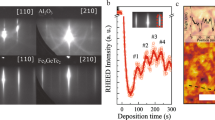Abstract
The recent discovery of ferromagnetism above room temperature in low-temperature-processed MnO2–ZnO has generated significant interest. Using suitably designed bulk and thin-film studies, we demonstrate that the ferromagnetism in this system originates in a metastable phase rather than by carrier-induced interaction between separated Mn atoms in ZnO. The ferromagnetism persists up to ∼980 K, and further heating transforms the metastable phase and kills the ferromagnetism. By studying the interface diffusion and reaction between thin-film bilayers of Mn and Zn oxides, we show that a uniform solution of Mn in ZnO does not form under low-temperature processing. Instead, a metastable ferromagnetic phase develops by Zn diffusion into the Mn oxide. Direct low-temperature film growth of Zn-incorporated Mn oxide by pulsed laser deposition shows ferromagnetism at low Zn concentration for an optimum oxygen growth pressure. Our results strongly suggest that the observed ferromagnetic phase is oxygen-vacancy-stabilized Mn2−xZnxO3−δ.
This is a preview of subscription content, access via your institution
Access options
Subscribe to this journal
Receive 12 print issues and online access
$259.00 per year
only $21.58 per issue
Buy this article
- Purchase on Springer Link
- Instant access to full article PDF
Prices may be subject to local taxes which are calculated during checkout



Similar content being viewed by others
References
Ohno, H. Making nonmagnetic semiconductors ferromagnetic. Science 281, 951–956 (1998).
Prinz, G.A. Magnetoelectronics. Science 282, 1660–1663 (1998).
Wolf, S.A. et al. Spintronics: A spin-based electronics vision for the future. Science 294, 1488–1495 (2001).
Das Sarma, S. A new device based on quantum spin rather than on charge, may yield the next generation of microelectronics. Am. Sci. 89, 516–523 (2001).
Ohno, H. et al. (Ga,Mn)As: A new diluted magnetic semiconductor based on GaAs. Appl. Phys. Lett. 69, 363–365 (1996).
Matsukura, F. et al. Magnetic circular dichroism studies of carrier-induced ferromagnetism in Ga1-xMnxAs. Phys. Rev. Lett. 83, 3073–3076 (1999).
Matsumoto, Y. et al. Room-temperature ferromagnetism in transparent transition metal-doped titanium dioxide. Science 291, 854–856 (2001).
Shinde, S.R. et al. Ferromagnetism in laser deposited anatase Ti1-xCoxO2-δ films. Phys. Rev. B 67, 115211 (2003).
Ogale, S.B. et al. High temperature ferromagnetism with a giant magnetic moment in transparent Co-doped SnO2-δ . Phys. Rev. Lett. 91, 077205 (2003).
Shinde, S.R. et al. Co-occurrence of superparamagnetism and anomalous Hall effect in highly reduced cobalt doped rutile TiO2 films. Phys. Rev. Lett. 92, 166601 (2004).
Coey, J.M.D., Douvalis, A.P., Fitzerald, C.B. & Venkatesan, M. Ferromagnetism in Fe-doped SnO2 thin films. Appl. Phys. Lett. 84, 1332 (2004).
Sharma, P. et al. Ferromagnetism above room temperature in bulk and transparent thin films of Mn-doped ZnO. Nature Mater. 2, 673–677 (2003).
Fukumura, T., Jin, Z., Ohtomo, A., Koinuma, H. & Kawasaki, M. An oxide-diluted magnetic semiconductor: Mn-doped ZnO. Appl. Phys. Lett. 75, 3366–3368 (1999).
Fukumura, T. et al. Magnetic properties of Mn-doped ZnO. Appl. Phys. Lett. 78, 958–960 (2001).
Ueda, K., Tabata, H. & Kawai, T. Magnetic and electric properties of transition-metal-doped ZnO films. Appl. Phys. Lett. 79, 988–990 (2001).
Ando, K. et al. Magneto-optical properties of ZnO-based diluted magnetic semiconductors. J. Appl. Phys. 89, 7284–7286 (2001).
Kolesnik, S., Dabrowski, B. & Mais, J. Origin of spin-glass behavior in Zn1-xMnxO. J. Supercond. 15, 251–255 (2002).
Tiwari, A. et al. Structural, optical and magnetic properties of diluted magnetic semiconducting Zn1-xMnxO films. Solid State Commn. 121, 371–374 (2002).
Jung, S.W. et al. Ferromagnetic properties of Zn1-xMnxO epitaxial thin films. Appl. Phys. Lett. 80, 4561–4563 (2002).
Han, S.-J. et al. Magnetism in Mn-doped ZnO bulk samples prepared by solid state reaction. Appl. Phys. Lett. 83, 920–922 (2003).
Cheng, X.M. & Chien, C.L. Magnetic properties of epitaxial Mn-doped ZnO thin films. J. Appl. Phys. 93, 7876–7878 (2003).
Yoon, S.W. et al. Magnetic properties of ZnO-based diluted magnetic semiconductors. J. Appl. Phys. 93, 7879–7881 (2003).
Kim, Y.M., Yoon, M., Park, I.-W., Park, Y.J. & Lyou, J.H. Synthesis and magnetic properties of Zn1-xMnxO films prepared by the sol-gel method. Solid State Commun. 129, 175–178 (2004).
Dietl, T., Ohno, H., Matsukura, F., Cibert, J. & Ferrand, D. Zener model description of ferromagnetism in zinc-blende magnetic semiconductors. Science 287, 1019–1022 (2000).
Acknowledgements
The authors gratefully acknowledge support under Defense Advanced Research Projects Agency grant number N000140210962 and National Science Foundation-MRSEC DMR-00-80008, including support under NSF-MRSEC for shared experimental facilities of PLD and RBS at the Center for Superconductivity Research, University of Maryland. The authors would like to thank Sang Wook Cheong, Sankar Das Sarma and Richard Greene for fruitful discussions.
Author information
Authors and Affiliations
Corresponding author
Ethics declarations
Competing interests
The authors declare no competing financial interests.
Supplementary information
Rights and permissions
About this article
Cite this article
Kundaliya, D., Ogale, S., Lofland, S. et al. On the origin of high-temperature ferromagnetism in the low-temperature-processed Mn–Zn–O system. Nature Mater 3, 709–714 (2004). https://doi.org/10.1038/nmat1221
Received:
Accepted:
Published:
Issue Date:
DOI: https://doi.org/10.1038/nmat1221
This article is cited by
-
Defects mediated weak ferromagnetism in Zn1−yCyO (0.00 ≤ y ≤ 0.10) nanorods semiconductors for spintronics applications
Scientific Reports (2023)
-
Synthesis, characterization and spectroscopic properties of Cu2+:ZnO, Ce3+:ZnO, and Cu2+, Ce3+:ZnO
Applied Physics A (2020)
-
Origin of ferromagnetism in Cu-doped ZnO
Scientific Reports (2019)
-
Structural and optical characterization of Sm-doped ZnO nanoparticles
Bulletin of Materials Science (2019)
-
Effect of Annealing Temperature on Structure and Magnetic Properties of Zn0.94Mg0.01Mn0.05O Nanoparticles
Journal of Superconductivity and Novel Magnetism (2019)



